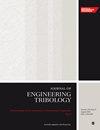High temperature tribological response of Fe-2Cu-0.8C-CaF2 self-lubricating composites at high speeds
IF 1.6
3区 工程技术
Q3 ENGINEERING, MECHANICAL
Proceedings of the Institution of Mechanical Engineers, Part J: Journal of Engineering Tribology
Pub Date : 2024-02-25
DOI:10.1177/13506501241233356
引用次数: 0
Abstract
In this work, Fe-2Cu-0.8C-CaF2 self-lubricating composites with calcium fluoride solid lubricant (3 □ 12 wt.%) were examined for their friction and wear at 5 and 10 m/s, at 500 °C. Addition of CaF2 decreased density and hardness of composites. During sliding, materials gained weight due to oxidation. Compared to the base matrix (Fe-2Cu-0.8C), composites showed lower weight gain and lower coefficient of friction. Increase in porosity with CaF2 content increased oxidation resulting in higher weight gain and increased friction due to wear debris abrasion. Increase in speed reduced weight gain due to higher material loss. Adhesion was the dominant wear mechanism in base matrix; delamination and wear debris abrasion in composites. Temperature rise at sliding surfaces was theoretically estimated. Increase in speed increased temperature, which reduced friction due to softening and shearing of solid lubricant. Composite with 3 wt.% CaF2 showed least surface damage and 6 wt.% showed lowest coefficient of friction, i.e., lower by 16% and 10% at 5, 10 m/s than base matrix. Tribological response of the composites to a broad range of applied parameters, viz. speed, load and temperature taken from earlier works and present work is briefly summarized. The study suggests the dominant role of CaF2 content and the wear debris in altering the tribological response. Further, the stability of the developed composites at high temperature and high load conditions was also established. The study suggests that the developed composites could serve high-load and high-temperature applications for heavy machinery such as bearings, shafts and gears.高速条件下 Fe-2Cu-0.8C-CaF2 自润滑复合材料的高温摩擦学响应
在这项工作中,研究了含有氟化钙固体润滑剂(3 □ 12 wt.%)的 Fe-2Cu-0.8C-CaF2 自润滑复合材料在 500 °C、5 m/s 和 10 m/s 下的摩擦和磨损情况。添加 CaF2 会降低复合材料的密度和硬度。在滑动过程中,材料因氧化而增重。与基体(Fe-2Cu-0.8C)相比,复合材料的重量增加较少,摩擦系数较低。孔隙率随着 CaF2 含量的增加而增加,从而增加了氧化作用,导致重量增加,并由于磨损碎片的磨蚀而增加了摩擦力。由于材料损耗增加,速度的增加降低了增重。在基体中,粘附是主要的磨损机制;在复合材料中,分层和磨损碎片磨损是主要的磨损机制。对滑动表面的温升进行了理论估算。速度的增加使温度升高,固体润滑剂的软化和剪切降低了摩擦力。含有 3 wt.% CaF2 的复合材料表面损伤最小,含有 6 wt.% CaF2 的复合材料摩擦系数最低,即在 5 米/秒和 10 米/秒的速度下分别比基本基体低 16% 和 10%。本文简要总结了复合材料对各种应用参数(即速度、载荷和温度)的摩擦学响应,这些参数来自早期研究和本研究。研究表明,CaF2 含量和磨损碎片在改变摩擦响应方面起着主导作用。此外,还确定了所开发的复合材料在高温和高负荷条件下的稳定性。研究表明,所开发的复合材料可用于轴承、轴和齿轮等重型机械的高负荷和高温应用。
本文章由计算机程序翻译,如有差异,请以英文原文为准。
求助全文
约1分钟内获得全文
求助全文
来源期刊

CiteScore
4.20
自引率
5.00%
发文量
110
审稿时长
6.1 months
期刊介绍:
The Journal of Engineering Tribology publishes high-quality, peer-reviewed papers from academia and industry worldwide on the engineering science associated with tribology and its applications.
"I am proud to say that I have been part of the tribology research community for almost 20 years. That community has always seemed to me to be highly active, progressive, and closely knit. The conferences are well attended and are characterised by a warmth and friendliness that transcends national boundaries. I see Part J as being an important part of that community, giving us an outlet to publish and promote our scholarly activities. I very much look forward to my term of office as editor of your Journal. I hope you will continue to submit papers, help out with reviewing, and most importantly to read and talk about the work you will find there." Professor Rob Dwyer-Joyce, Sheffield University, UK
This journal is a member of the Committee on Publication Ethics (COPE).
文献相关原料
| 公司名称 | 产品信息 | 采购帮参考价格 |
|---|
 求助内容:
求助内容: 应助结果提醒方式:
应助结果提醒方式:


